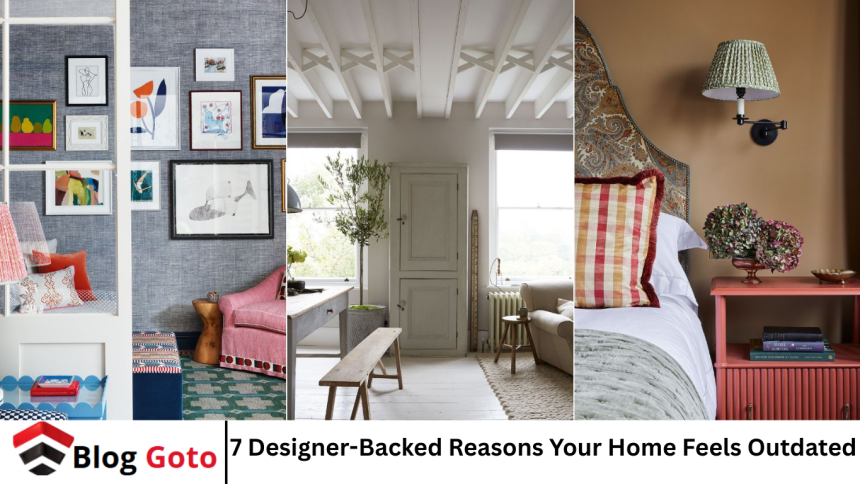You walk into your living room and feel something’s off. It’s not necessarily dirty or cluttered, but it just doesn’t feel fresh or inviting. That “dated” feeling can sneak up on you, especially if you’ve been in the same home for years. According to interior designers, some common decor choices and outdated trends could be making your home feel older than it actually is.
In this guide, we’ll walk you through the 7 biggest designer-flagged culprits that make a space feel outdated—along with practical tips on how to refresh and modernize your home without a complete renovation. These insights go beyond just paint colors and furniture—they target how your home feels to you and your guests.
Have you ever walked into your home and felt like something just isn’t quite right—but you can’t pinpoint why? You’re not alone. Interior designers agree that certain elements can instantly make a home feel stuck in the past, even if everything is clean and well-kept.
More Read: How to Climate-Proof Your Home: 5 Essential Upgrades
Overuse of Tuscan or Brown-on-Brown Color Palettes
Why Designers Flag It:
The once-popular Tuscan-inspired look—with heavy browns, golds, and ornate furniture—feels dark and heavy in today’s design world. The excessive use of brown-on-brown tones can make a home feel dated and even gloomy.
How to Fix It:
- Swap dark brown furniture or cabinetry with lighter wood finishes or painted options.
- Add contrast with white, soft beige, or sage green walls.
- Incorporate modern neutrals and textures—linen, boucle, or matte ceramics.
Design Tip: Natural light plays a big role. Consider sheer curtains to brighten spaces dominated by darker tones.
Wall-to-Wall Carpeting in Main Living Areas
Why Designers Flag It:
Wall-to-wall carpet was a status symbol in the ’70s and ’80s, but today, it often traps dust and feels less fresh than wood or laminate flooring. Even high-pile carpet in bedrooms can age a space.
How to Fix It:
- Replace carpeting with luxury vinyl plank, engineered hardwood, or polished concrete.
- Use stylish area rugs to add warmth and personality without committing wall-to-wall.
Design Tip: Go for rugs with contemporary patterns or textures to anchor the room while making it feel current.
Old-Fashioned Light Fixtures and Ceiling Fans
Why Designers Flag It:
Brassy chandeliers, frosted glass dome fixtures, or builder-grade ceiling fans scream late ’90s. Lighting is one of the easiest ways to update a space’s mood and look.
How to Fix It:
- Replace dated fixtures with sleek, modern lighting—think matte black, brushed brass, or minimalist LED designs.
- Try layered lighting: table lamps, floor lamps, and wall sconces to add depth.
Design Tip: Smart lighting (with dimmers or app controls) brings a modern, functional edge that’s especially useful in multipurpose rooms.
Heavy Drapery and Valances
Why Designers Flag It:
Thick, decorative valances and draperies with ornate tassels or fringe create a heavy, formal atmosphere that contrasts sharply with today’s clean-lined, casual interiors.
How to Fix It:
- Remove valances and replace with light, airy curtains in cotton, linen, or sheer fabrics.
- Consider minimalist roller shades or wooden blinds for a sleek look.
Design Tip: Mount curtains high and wide to create the illusion of taller ceilings and larger windows.
Matching Furniture Sets
Why Designers Flag It:
Buying a full bedroom or living room set used to be a go-to move, but it’s now viewed as overly matchy and uninspired. It limits creativity and makes your home look like a catalog from 2003.
How to Fix It:
- Break up the set. Keep your bed frame but swap out nightstands or dressers for unique pieces.
- Introduce vintage or artisan elements—thrifted chairs, handwoven textiles, or a statement mirror.
Design Tip: Mixing finishes (metal, wood, rattan) adds texture and makes the room feel curated rather than copy-pasted.
Popcorn Ceilings and Dated Wall Textures
Why Designers Flag It:
Popcorn ceilings and textured walls were meant to hide imperfections, but now they simply signal a home stuck in the past. They also collect dust and are difficult to clean.
How to Fix It:
- Hire a professional to remove popcorn ceiling safely (especially if built before the 1980s).
- Skim-coat or refinish textured walls to create a smooth, modern look.
Design Tip: Once smooth, paint your ceilings a fresh white or soft tone that enhances light reflection.
Outdated Bathroom and Kitchen Fixtures
Why Designers Flag It:
Brass towel racks, plastic sink handles, and tiled countertops were trendy decades ago—but now feel clunky and inefficient. Kitchens and bathrooms tend to age the fastest.
How to Fix It:
- Swap fixtures for matte black, brushed nickel, or champagne bronze options.
- Reface cabinetry or simply update hardware (handles and knobs).
- Replace outdated countertops with quartz or butcher block for an instant refresh.
Design Tip: Even small changes—like switching out an old mirror for a round, backlit one—can make a bathroom feel high-end.
Easy Upgrades That Make a Big Impact
You don’t need a full remodel to bring your home into the present. Here are a few universal upgrades that interior designers recommend for modernizing any space:
- Paint: Choose updated hues like greige, soft sage, or crisp whites.
- Hardware: Swapping out doorknobs, cabinet pulls, and faucets can do wonders.
- Artwork: Say goodbye to generic art prints and hello to original, meaningful pieces.
- Plants: Greenery brings freshness and vibrancy to tired rooms.
- Decluttering: A modern home is a simplified one. Edit ruthlessly.
Frequently Asked Question
What is the most common reason a home feels outdated?
The overuse of specific color palettes like beige-on-beige or brown-on-brown is a key culprit. Designers often cite lighting, textures, and heavy materials as contributors to a dated aesthetic.
Is it expensive to update a dated home?
Not necessarily. Many updates, such as changing hardware, painting, or replacing lighting fixtures, can be done on a modest budget. Even small changes can make a huge visual impact.
What color schemes feel most modern in 2025?
Soft neutrals like greige, off-white, and taupe paired with accents like muted greens, blues, and matte black are on trend. Natural wood tones and textures also give a contemporary, grounded feel.
Are wallpaper borders or accent walls still in style?
Wallpaper borders are considered outdated by most designers. However, modern wallpaper used on full walls or entire rooms is having a comeback—especially in bold, botanical, or geometric prints.
How can I update my kitchen without renovating?
Simple updates include replacing cabinet hardware, painting or refacing cabinets, installing a peel-and-stick backsplash, and updating light fixtures. Swapping countertops for quartz or butcher block adds a huge style lift.
Can I mix design styles to modernize my home?
Yes—mixing styles (like mid-century modern with rustic or minimalist with vintage) is encouraged. The key is balance. Use one style as the base and others as accents to avoid a chaotic look.
How do I know if my furniture is dating my home?
If your furniture came in a matching set, is overly ornate, or heavily padded with bulky silhouettes, it may be aging your space. Swapping in modern, streamlined pieces or mixing in unique items can help.
Conclusion
A home that feels outdated isn’t necessarily falling apart—it may just need a style tune-up. By identifying the key areas designers say age a space the most, you can focus your efforts on high-impact changes. Whether it’s updating your light fixtures, removing heavy drapes, or saying goodbye to that 2002 furniture set, small but strategic choices can breathe new life into your home. Remember: It’s not about chasing every trend but choosing timeless elements that reflect your personality while keeping your home feeling fresh, current, and comfortable.











